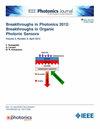Design Guidelines for Optical Camera Communication Systems: A Tutorial
IF 2.1
4区 工程技术
Q3 ENGINEERING, ELECTRICAL & ELECTRONIC
引用次数: 0
Abstract
The rapid development of the Internet of Things (IoT) has put great challenges on the next generation's communication technologies. Optical Camera Communication (OCC), with its advantages of the green principle, less electromagnetic interference, and harmonious integrations, can serve as a complementary, and sometimes viable alternative technology to mainstream Radio Frequency (RF)-based one. Designing efficient OCC platforms crucially involves accurate modeling of the OCC system and evaluating the efficiency of OCC-based techniques, which then stimulates related practical applications. This paper aims to provide a systematic perspective to understand OCC and to present design guidelines for OCC systems from theory to practice. First, the main parameters and analytical models for OCC basic components are presented to provide guidance on hardware parameter selection and system simulations. Next, typical implementation procedures and common performance evaluation criteria for an overall OCC system are provided. Then, detailed goal-oriented OCC enhancement solutions are summarized aiming to provide systematic guidelines for system performance enhancement. Finally, OCC designed examples are presented based on the results of our OCC experimental platform and some future research directions are discussed.光学相机通信系统设计指南:教程
物联网(IoT)的快速发展对下一代通信技术提出了巨大挑战。光摄像通信(OCC)具有绿色环保、电磁干扰少、集成度高的优点,可以作为主流射频(RF)技术的补充,有时甚至是可行的替代技术。设计高效的 OCC 平台,关键在于对 OCC 系统进行精确建模,评估基于 OCC 技术的效率,进而促进相关的实际应用。本文旨在提供一个系统的视角来理解 OCC,并从理论到实践提出 OCC 系统的设计指南。首先,介绍 OCC 基本组件的主要参数和分析模型,为硬件参数选择和系统仿真提供指导。接着,介绍了整个 OCC 系统的典型实施程序和通用性能评估标准。然后,总结了详细的以目标为导向的 OCC 增强解决方案,旨在为系统性能增强提供系统指导。最后,根据我们的 OCC 实验平台的结果介绍了 OCC 设计实例,并讨论了一些未来的研究方向。
本文章由计算机程序翻译,如有差异,请以英文原文为准。
求助全文
约1分钟内获得全文
求助全文
来源期刊

IEEE Photonics Journal
ENGINEERING, ELECTRICAL & ELECTRONIC-OPTICS
CiteScore
4.50
自引率
8.30%
发文量
489
审稿时长
1.4 months
期刊介绍:
Breakthroughs in the generation of light and in its control and utilization have given rise to the field of Photonics, a rapidly expanding area of science and technology with major technological and economic impact. Photonics integrates quantum electronics and optics to accelerate progress in the generation of novel photon sources and in their utilization in emerging applications at the micro and nano scales spanning from the far-infrared/THz to the x-ray region of the electromagnetic spectrum. IEEE Photonics Journal is an online-only journal dedicated to the rapid disclosure of top-quality peer-reviewed research at the forefront of all areas of photonics. Contributions addressing issues ranging from fundamental understanding to emerging technologies and applications are within the scope of the Journal. The Journal includes topics in: Photon sources from far infrared to X-rays, Photonics materials and engineered photonic structures, Integrated optics and optoelectronic, Ultrafast, attosecond, high field and short wavelength photonics, Biophotonics, including DNA photonics, Nanophotonics, Magnetophotonics, Fundamentals of light propagation and interaction; nonlinear effects, Optical data storage, Fiber optics and optical communications devices, systems, and technologies, Micro Opto Electro Mechanical Systems (MOEMS), Microwave photonics, Optical Sensors.
 求助内容:
求助内容: 应助结果提醒方式:
应助结果提醒方式:


